Garmin Forerunner 255 review: Running back to the top
The Garmin Forerunner 255 is an excellent update to a fan favorite. It adds a few sensors that the Forerunner 245 sorely lacked, and new Garmin Pay support lets you ditch your wallet. With two sizes to choose from and optional music integration, this is the most flexible Garmin running watch yet and easily establishes its place among running royalty.
The Garmin Forerunner 245 was, by all accounts, a great running watch. A winning combo of size, price, and battery life kept it floating among our favorites for over three years. However, three years is an eternity in the wearables game. Features that weren’t common at launch are now must-haves, and it was time for this reasonably priced watch to catch up with the times. Garmin makes many of those promises, but is it enough to race back onto the podium? Find out in our Garmin Forerunner 255 review.
What you need to know about the Garmin Forerunner 255
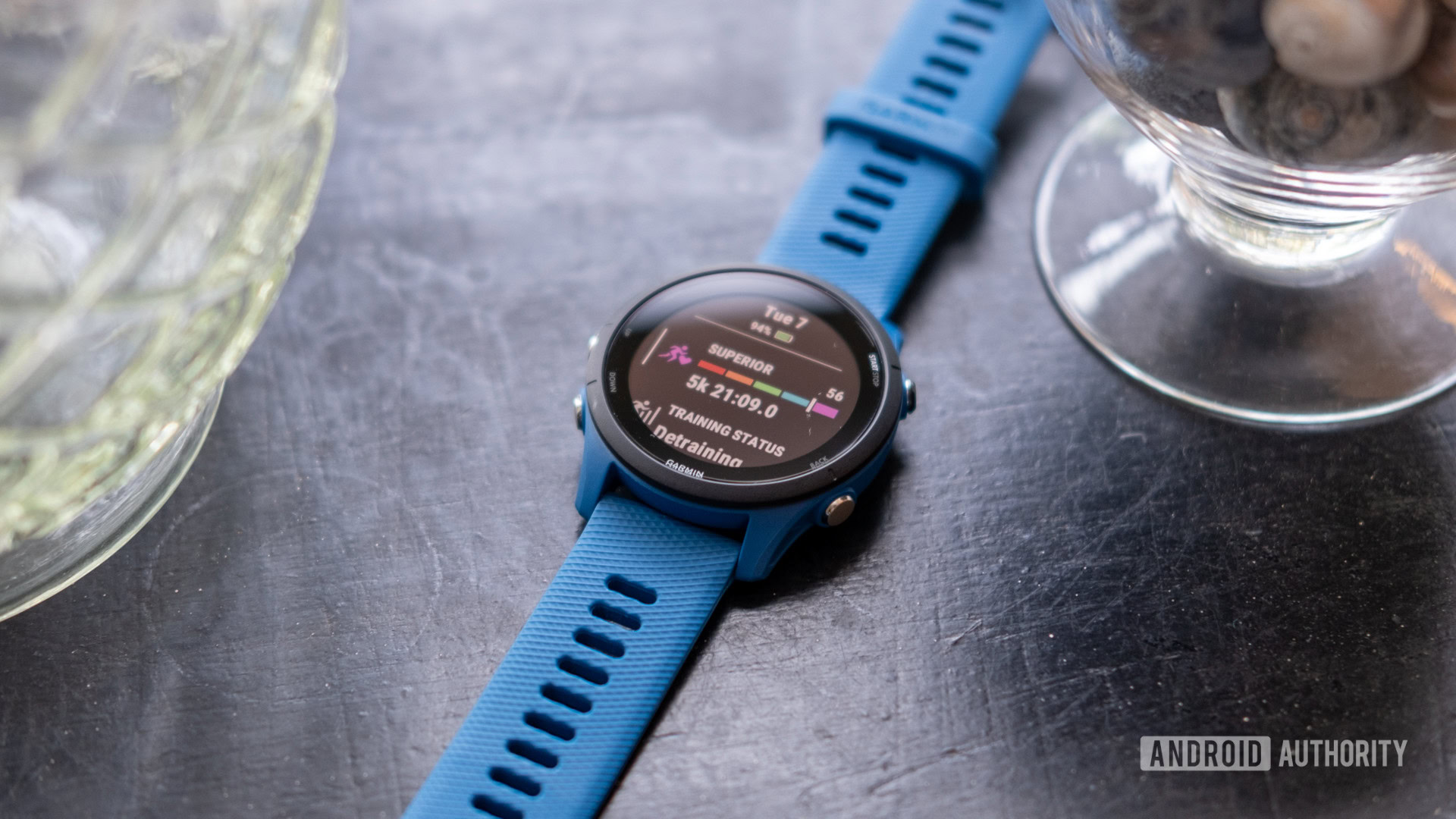
Ryan Haines / Android Authority
- Garmin Forerunner 255/255S: $349 / €349 / £299
- Garmin Forerunner 255 Music: $399 / €399 / £349
The Garmin Forerunner 255 arrived at the start of June 2022 as a refined, fitness-focused successor to the Forerunner 245 and the Forerunner 245 Music. It shares many of the same design traits as its predecessors, but the Forerunner 255 is more than just an iterative update. While Garmin offered its Forerunner 245 models in a single 42mm size, the Forerunner 255 now comes with options. Those with smaller wrists can opt for the 41mm Forerunner 255S, while larger wrists will feel more at home with the standard model.
Garmin’s petite Forerunner 255S packs a 1.1-inch Gorilla Glass 3 display with a 216 x 216 resolution. The larger version bumps up to a 1.3-inch display with a 260 x 260 resolution. Both versions combine a fiber-reinforced polymer bezel with a durable — and waterproof — silicone strap. Outside of the physical size, the most significant difference lies in the watch’s battery life. If you go for the 255S, you’re looking at up to 12 days of juice in smartwatch mode, while the bigger watch offers 14 days. Tapping into the GPS drops the smaller watch to 26 hours or 30 hours for the larger model.
Garmin’s Forerunner 255 series now includes a barometric altimeter and a gyroscope. The heart rate sensor is now a fourth-generation Elevate sensor, which should deliver more accurate measurements and raw HRV data. Garmin stuck with familiar GPS, GLONASS, and GALILEO sensors, though they now offer multi-frequency reception, providing better accuracy in narrow valleys and covered trails.
Two case sizes and a handful of new sensors make the Forerunner 255 one of Garmin’s most flexible watches yet.
If you prefer to listen to music while you run, Garmin also offers the Forerunner 255 Music. It’s available with 3GB of storage in both 41mm and 46mm case sizes and will set you back an extra $50. The Garmin Forerunner 255 series also supports NFC, which was missing from its predecessor. You can now use Garmin Pay to pick up a drink or snack mid-run if you’d rather leave your wallet behind.
The Forerunner 255 can connect to either Android or iOS devices via Bluetooth, but the Garmin Connect app is a must-have. It serves as your control center for software updates and allows you to add and remove payment methods for Garmin Pay. You’ll also need Garmin Connect to see a recap of your steps and upload fitness activities like runs and swims.
There’s not too much to mention in the Forerunner 255’s packaging. Garmin tossed in a proprietary charging cable (with a USB-A connector), basic documentation, and the watch itself.
The Garmin Forerunner 255 comes in a few different colors, depending on which version you pick up. Garmin’s standard 46mm watch is available in Tidal Blue or Slate Gray, while the smaller Forerunner 255S comes in Light Pink or Powder Gray. If you need tunes on the go, both sizes of the Forerunner 255 Music come in Whitestone and Black. Each color also comes with matching quick-release silicone bands. The 41mm Forerunner 255S requires 18mm bands, and the larger Forerunner 255 is equipped with 22mm bands.
What’s good?
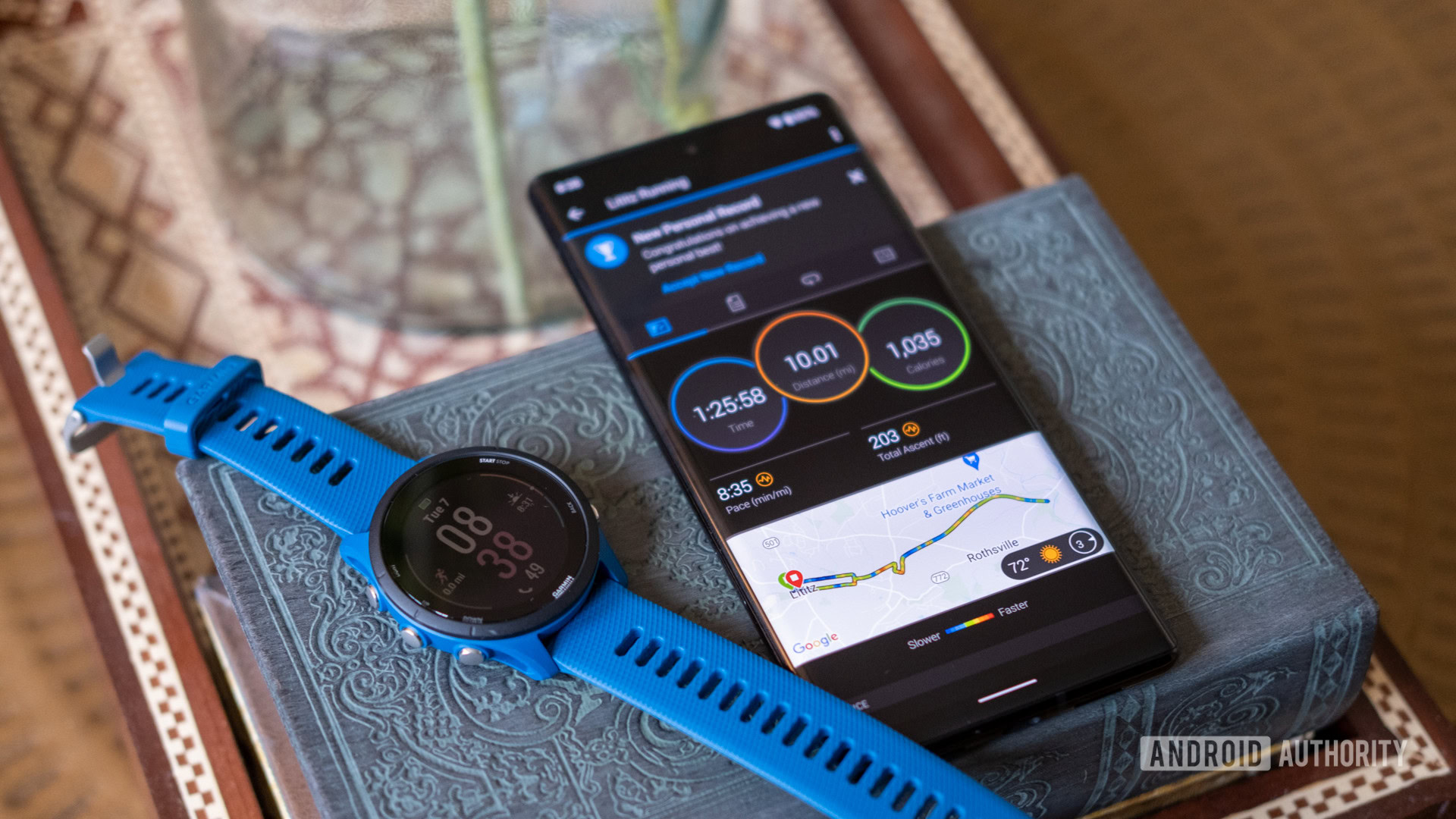
Ryan Haines / Android Authority
There’s a reason — or rather a few reasons — that we loved the Garmin Forerunner 245 so much. It was kind of like the Goldilocks of running watches. Not too big, but it offered solid battery life and accurate tracking at a reasonable price. Now, the Forerunner 255 picks up those strengths and takes them even further. It also fills a few of the gaps that users were clamoring for. NFC with Garmin Pay is the first one that springs to mind. I rarely run with money, and Garmin Pay makes it way easier to pay for a snack on the go.
As someone with smaller wrists, I’m happy to see Garmin bring its variety of sizes to the Forerunner 255 series. I tested the standard Forerunner 255 in the 46mm size and had no problems adjusting it to fit my wrist. The 41mm size is close to the Forerunner 245, while the 46mm version adds precious real estate for those who can afford the space. Even better, you don’t have to pony up extra cash for the bigger case — you can just opt for the size that fits you best. Garmin’s silicone band has plenty of holes, so you could always opt for the larger display and tighten the Forerunner 255 all the way down for the right fit.
Don’t you just love it when a manufacturer adds exactly what users want? Well done, Garmin.
Moving onto more critical upgrades, the battery life on the Forerunner 255 is excellent. I charged it when it arrived and didn’t need to fish out the proprietary charger until I wrote this review two weeks later. It’s far above the seven days of smartwatch mode that the previous Forerunner 245 offered. When I run, I’m usually out for an hour to 90 minutes, and I managed to record ten ventures across two weeks. That’s not too shabby.
Sometimes asking for new running watch features feels like shouting into the void. However, it’s nice to see Garmin listening to what the people want. For example, the Garmin Forerunner 255 picked up Morning Report, a feature first seen on the Garmin Lily. Morning Report delivers an overview of your sleep, recovery, and training for the day right when you wake up, even if it’s a rest day. You can also check out regular HRV (heart rate variability) reports.
See also: The best smartwatches for women
After three years, the Forerunner 245’s heart rate sensor was starting to show its age. The fourth-generation Elevate sensor is a significant improvement. It’s more accurate with almost-constant readings, and I found that it nearly matched my Polar H10 chest strap. The new gyroscope and barometric altimeter provide better insights into key workout metrics like elevation.
Garmin added its powerful triathlon feature, too. It’s one of more than 30 sport profiles, and you can shift from the running phase of your workout to biking or swimming with the push of a button. I’ll admit that I stuck to running for the bulk of my testing, but there’s bound to be an activity type for just about anyone.
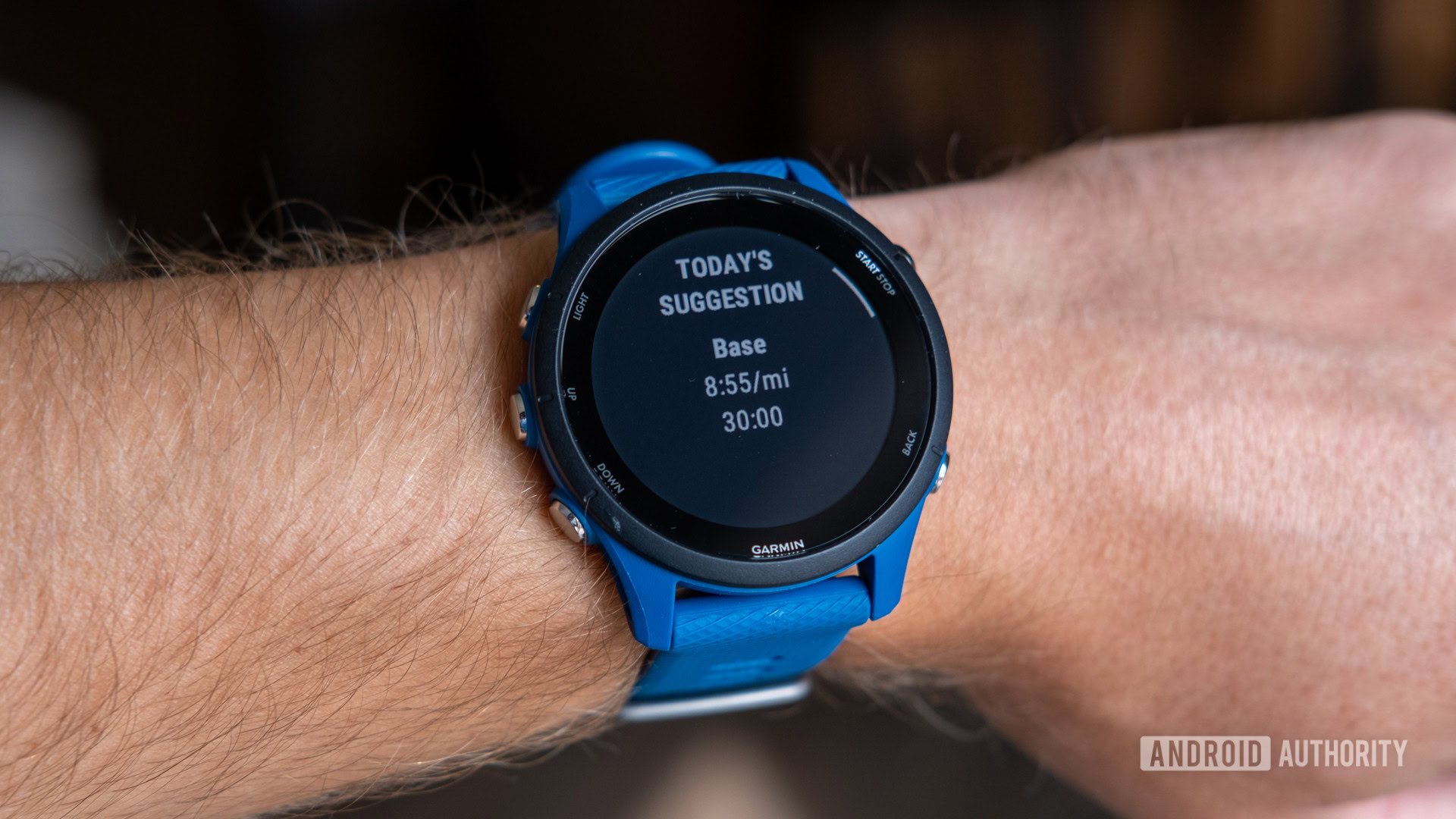
Ryan Haines / Android Authority
I’ve never claimed to be the best at recovery, but the Forerunner 255 tries to take some of the guesswork out of my hands. The HRV measurement mentioned before plays a key role in Garmin’s workout recommendations, which you can see above. I took a few days off, and the Forerunner 255 adapted for a couple of easier miles in place of the eight miles my prescribed training plan demanded.
Garmin tracks your rest and exertion in the form of a Body Battery, which is also part of the recovery calculation. It incorporates the time since your last workout and how hard you pushed to give you a score out of 100. I’m still not great at following the recommended rest, but I’m getting there.
Elevation

Ryan Haines / Android Authority
The graph above doesn’t paint a great picture for one of my two watches. It’s a measure of the elevation along one of my regular routes, and it goes to show how vital a barometric altimeter can be. The Coros Pace 2 (green line) relies on a simple barometer to measure the air pressure and convert it to elevation. However, Garmin’s new barometric altimeter does double duty. It simultaneously measures as an altimeter, where all pressure changes impact elevation, and as a barometer, where pressure measurements include changes in the weather and ambient pressure.
The Forerunner 255 then balances the barometric reading against the altimetric to determine your actual elevation. Garmin also recommends the altimeter as more reliable for workouts with significant elevation changes, while the barometer is more reliable for activities with less elevation change. In this case, I trust Garmin’s results over those from Coros. I ran hill repeats, and the consistent lines to the right of the graph paint a better picture of the effort.
Heart rate
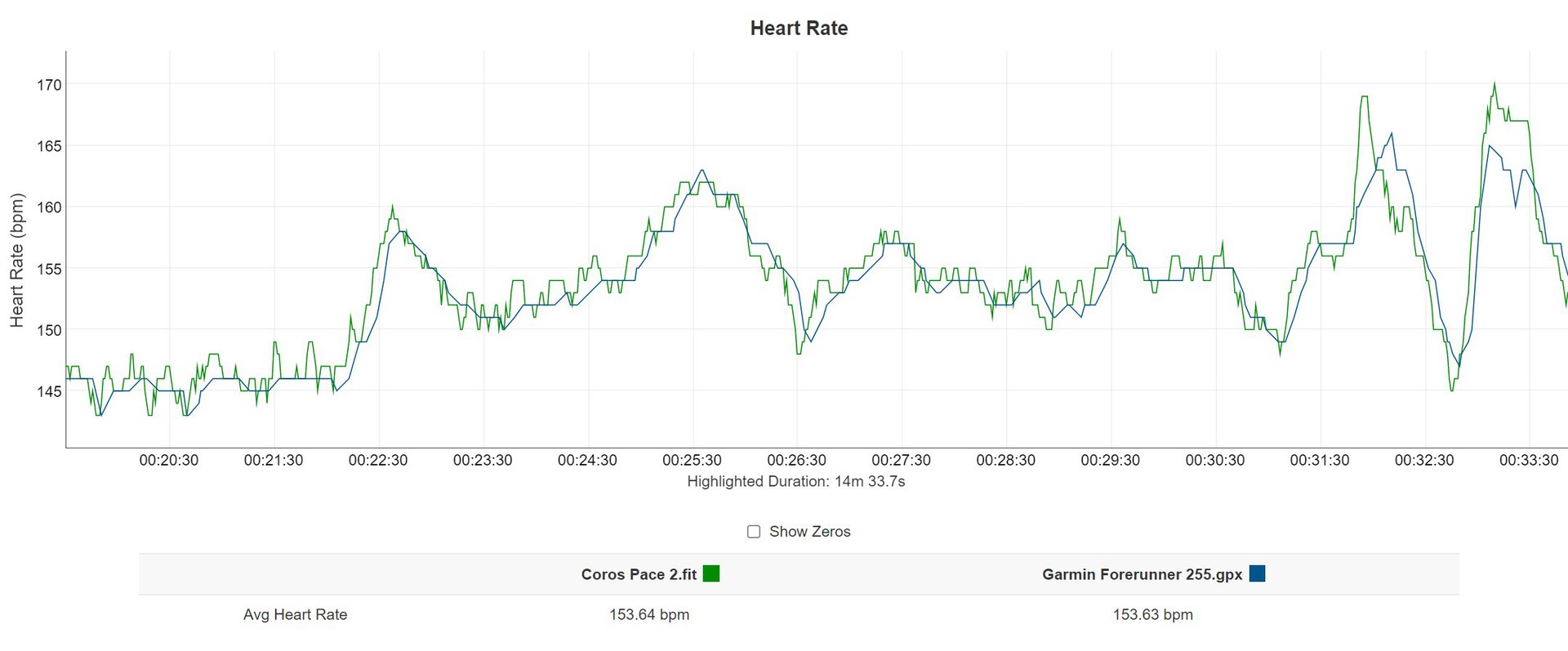
Ryan Haines / Android Authority
Garmin deserves major props for its updated heart rate sensor. I mentioned previously that it’s now a fourth-generation Elevate sensor, and it’s spot-on compared to my Coros Pace 2, which is paired to a Polar H10 chest strap. The Forerunner 255 shows less fluctuation across the workout and flat sections, whereas the Pace 2 indicated rapid change. It’s an impressive result for a wrist sensor to average within 0.01 bpm of a chest strap.
See also: The best heart rate monitors and watches
Location
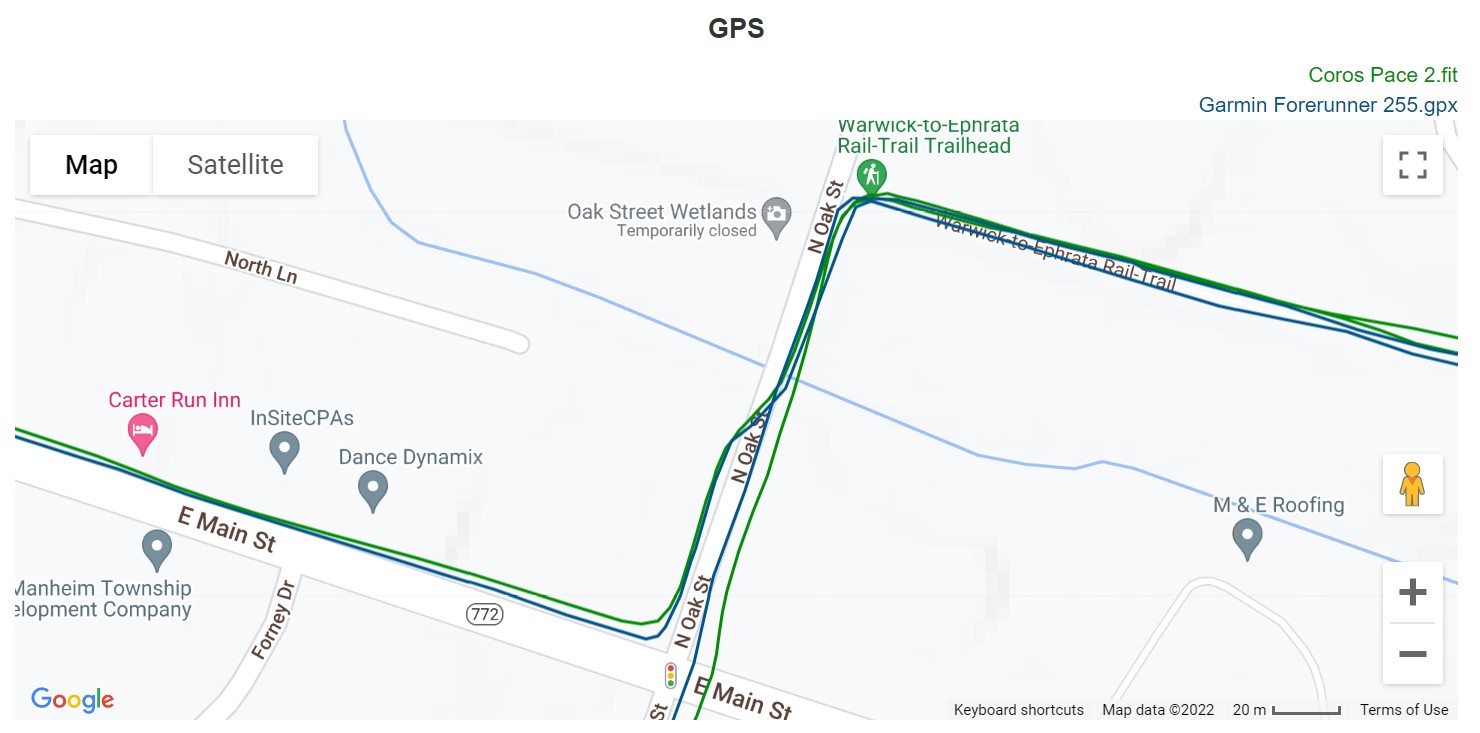
Ryan Haines / Android Authority
The GPS accuracy on Garmin’s Forerunner 255 is excellent as well. I kept it on my right wrist for all of my runs, and the map reflects that. Both tracks correctly indicate the side of the road I ran on, and the distance between the two lines is fairly consistent. The only points where both lines converge are where I tend to check my watch for pacing and distance. That section of rail-trail also features thick tree coverage, but the Forerunner 255 had no issues picking out which side of the pavement I was on.
What’s not so good?
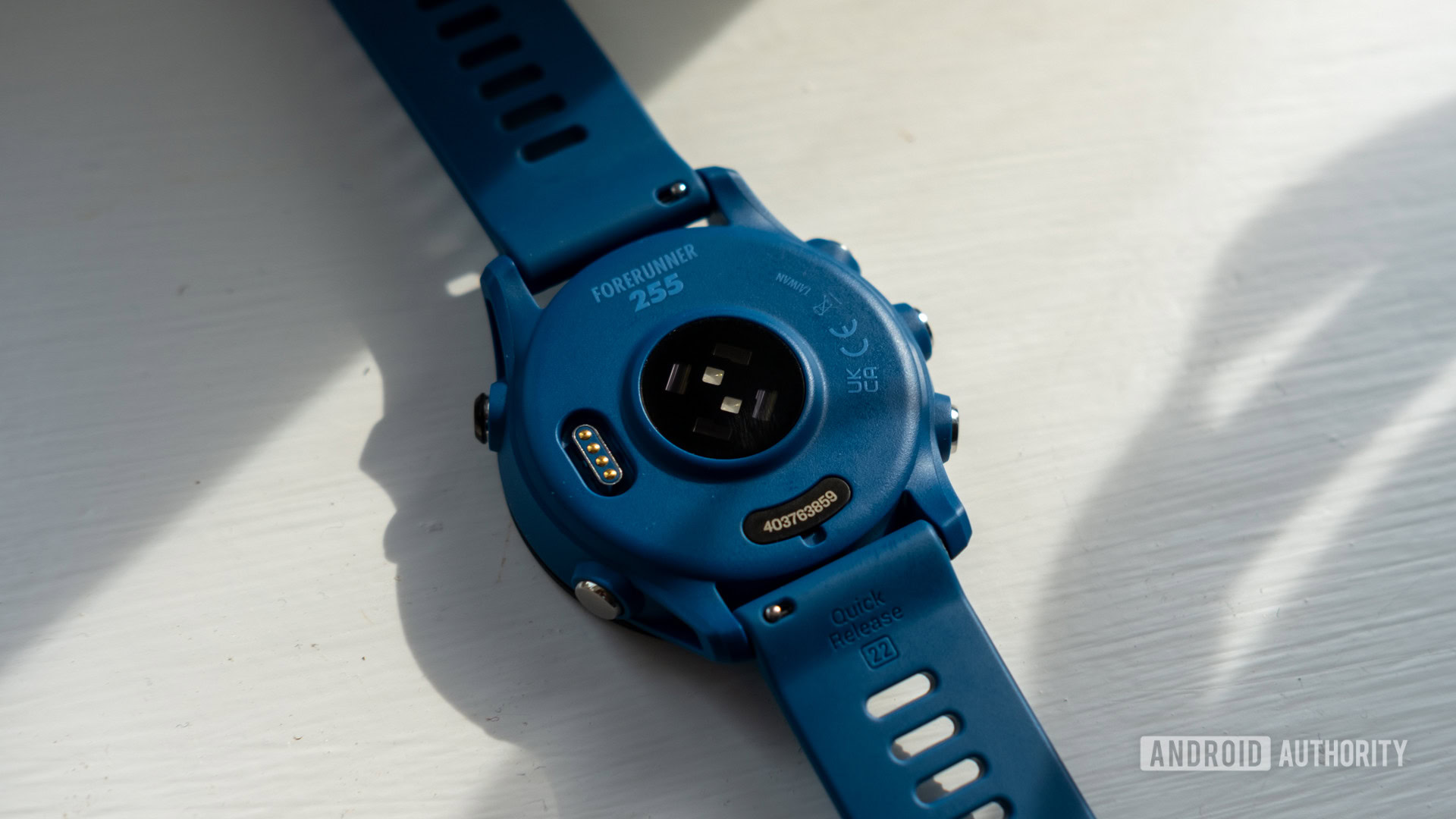
Ryan Haines / Android Authority
I can find precious little to complain about with the Garmin Forerunner 255. It rights the wrongs of its predecessor and updates some of the most dated features. However, there are a few spots where the running watch could improve. For starters, both versions of the Forerunner 255 come with a $50 premium over the Forerunner 245 series. The standard model is $349, while the music-enabled version is $399.
Five buttons can feel like a lot if you’re not already used to Garmin’s Forerunner ecosystem. The Forerunner 255 relies on different buttons for almost everything. The Up and Down buttons on the left side are essential for navigation, while the Start/Stop and Back buttons are the fastest way in and out of menus. Garmin’s fifth button is a backlight toggle, which could have just as easily been tucked away in the settings menu. There’s also no touchscreen on the Forerunner 255, but that’s not uncommon among dedicated running watches.
Five navigation buttons is a lot for a running watch — especially for a runner who lacks coordination.
It’s not too tough to adapt to the multi-button layout, but it’s proven tougher for me to adjust to the weight of the Forerunner 255. While it doesn’t exactly weigh your wrist down, the watch doesn’t disappear while running, either. I found myself constantly aware of the Forerunner’s presence, especially if I had a lighter watch on the other wrist. Garmin’s smaller 41mm version weighs in at 39g, while the larger version sits at 49g. It may not sound like much, but it’s a noticeable bump compared to running watches like the Coros Pace 2 at 30g and the Huawei Watch GT Runner at 38.5g.
Unfortunately, we’re all too happy to complain about proprietary charging on wearables these days. The Garmin Forerunner 255 doesn’t offer wireless charging, instead, it requires the four-pin connector that’s common to all Garmin running watches. It’s nice that Garmin packs one in the box, but it’s not a cable that you’re likely to have sitting around if you misplace the included one. I would have liked to see a Forerunner 255 Solar option, like its Forerunner 955 sibling, but that likely would have come with another price bump.
Garmin Forerunner 255 specs
| Garmin Forerunner 255/255S | |
|---|---|
|
Display |
41mm: 1.1-inch MIP, 218 x 218 resolution
46mm: 1.3-inch MIP, 260 x 260 resolution |
|
Dimensions and weight |
41mm: 41 x 41 x 12.4mm
39g w/o strap Fits wrists 110-175mm 46mm: 45.6 x 45.6 x 12.9mm |
|
Colors and materials |
41mm
Color: Powder Gray or Light Pink Material: Gorilla Glass 3 display, Fiber-reinforced polymer bezel, silicone strap 46mm |
|
Battery |
41mm
Up to 12 days in smartwatch mode Up to 26 hours in GPS-only GNSS mode Up to 20 hours in All-Systems GNSS mode 46mm |
|
Sensors |
GPS |
|
Durability |
5ATM |
|
Connectivity |
NFC |
|
Compatibility |
Android and iOS |
Garmin Forerunner 255 review: The verdict
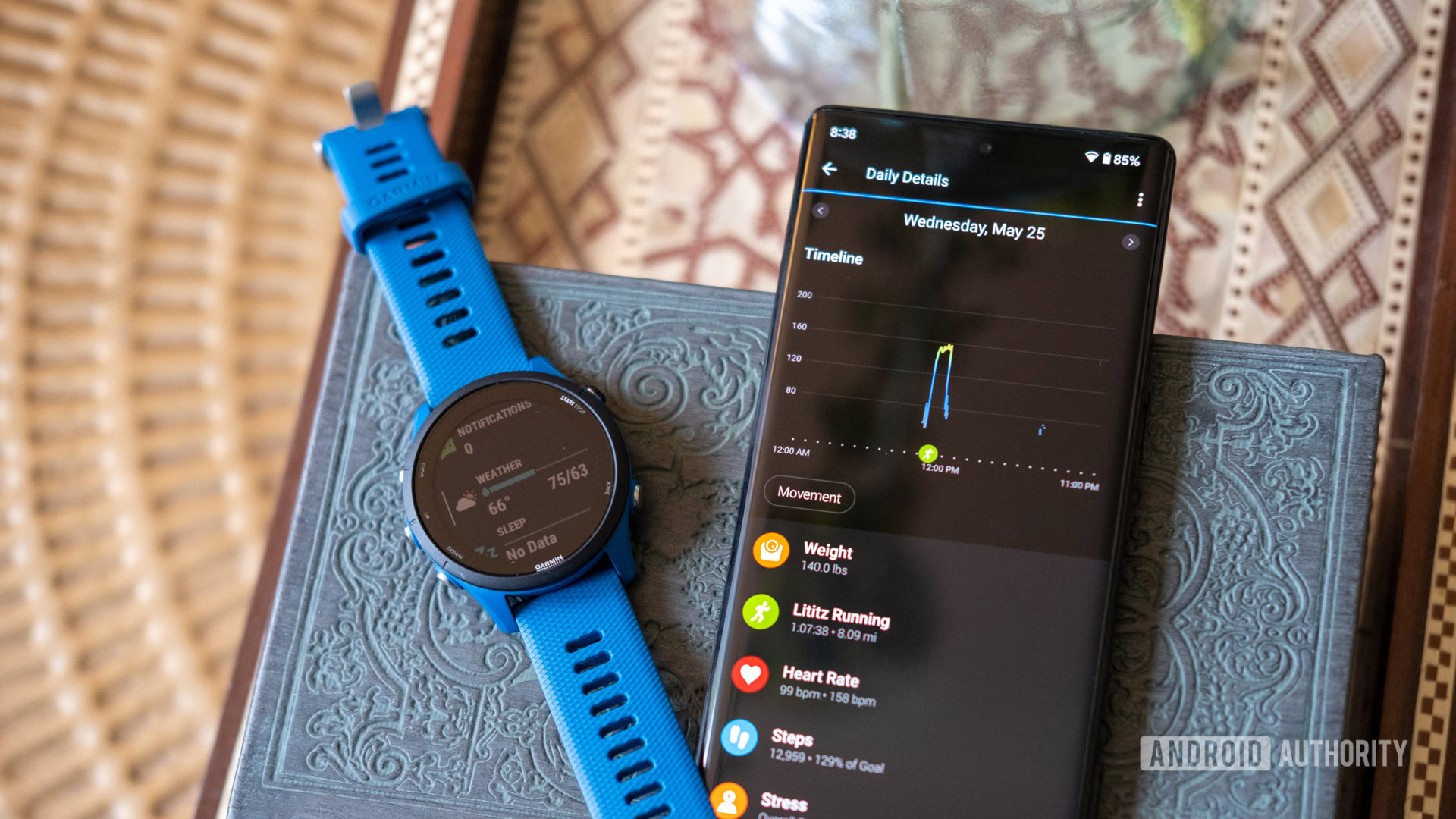
Ryan Haines / Android Authority
The Garmin Forerunner 255 is the update that the beloved Forerunner 245 deserved. It packs accurate GPS tracking with solid battery life and an attractive package. Garmin’s mid-level running watch is also more flexible than ever, with two case sizes and optional music support. It’s easy to recommend for Android and iOS users alike, and Triathlon Mode opens the Forerunner’s horizons beyond the usual running crowd.
Best of all, Garmin’s battery life got a solid boost and NFC support with Garmin Pay means you can free up some pocket space while you run (or bike or swim). The weight of the watch may take some getting used to, as will the five-button navigation, but those should be nothing new for longtime Garmin fans. No matter your navigation preference, Garmin’s integration with Android and iOS is excellent. The Connect app is easy to navigate, and it pairs with Strava for seamless workout sharing, or you can keep your data to yourself within the app.
The Forerunner 255 brings a fan favorite into 2022. It adds NFC, multiple sizes, and updated sensors to stay among running royalty.
Perhaps more important than sharing your workouts is how Garmin creates them for you. The training plans are carefully designed not to overwhelm you, and Garmin offers some of the best recovery insights around. It’s hard to take recovery seriously sometimes, but the Body Battery and adaptive training recommendations take a lot of the guesswork out of when to train and how hard.
Although the Garmin Forerunner 255 is an excellent fitness watch at $349, the mid-level wearable market is more competitive than ever. Top competitors like Coros, Suunto, and Polar all offer worthy rivals at around the same price tag. Polar’s Pacer Pro ($299) matches Garmin’s rugged Gorilla Glass 3 display and advanced running metrics. It comes ready for up to 35 hours of GPS and heart rate tracking on a single charge. The Suunto 5 Peak ($299) packs more than 80 sport modes and native music controls without having to drop an extra $50. It’s rated for 3ATM of pressure and nearly equals Garmin’s battery prowess.
Keep shopping: The best Garmin running watches you can buy
If you value battery life over anything else, the Coros Apex ($299) is the way to go. It comes in two sizes — 42mm and 46mm — and the larger model is rated for 30 days of juice in smartwatch mode or 35 hours of GPS tracking. The Apex also offers map and navigation features, which you’d have to upgrade to the Forerunner 955 ($499) to get from Garmin. Garmin’s flagship running watch adds longer battery life and optional solar charging to the mix, too. If you’re ready for life in the rough, the Garmin Instinct 2 ($349) is another good choice. It’s built tough with water resistance up to 100 meters, and the basic black and white display sips power for up to 28 days of battery life.
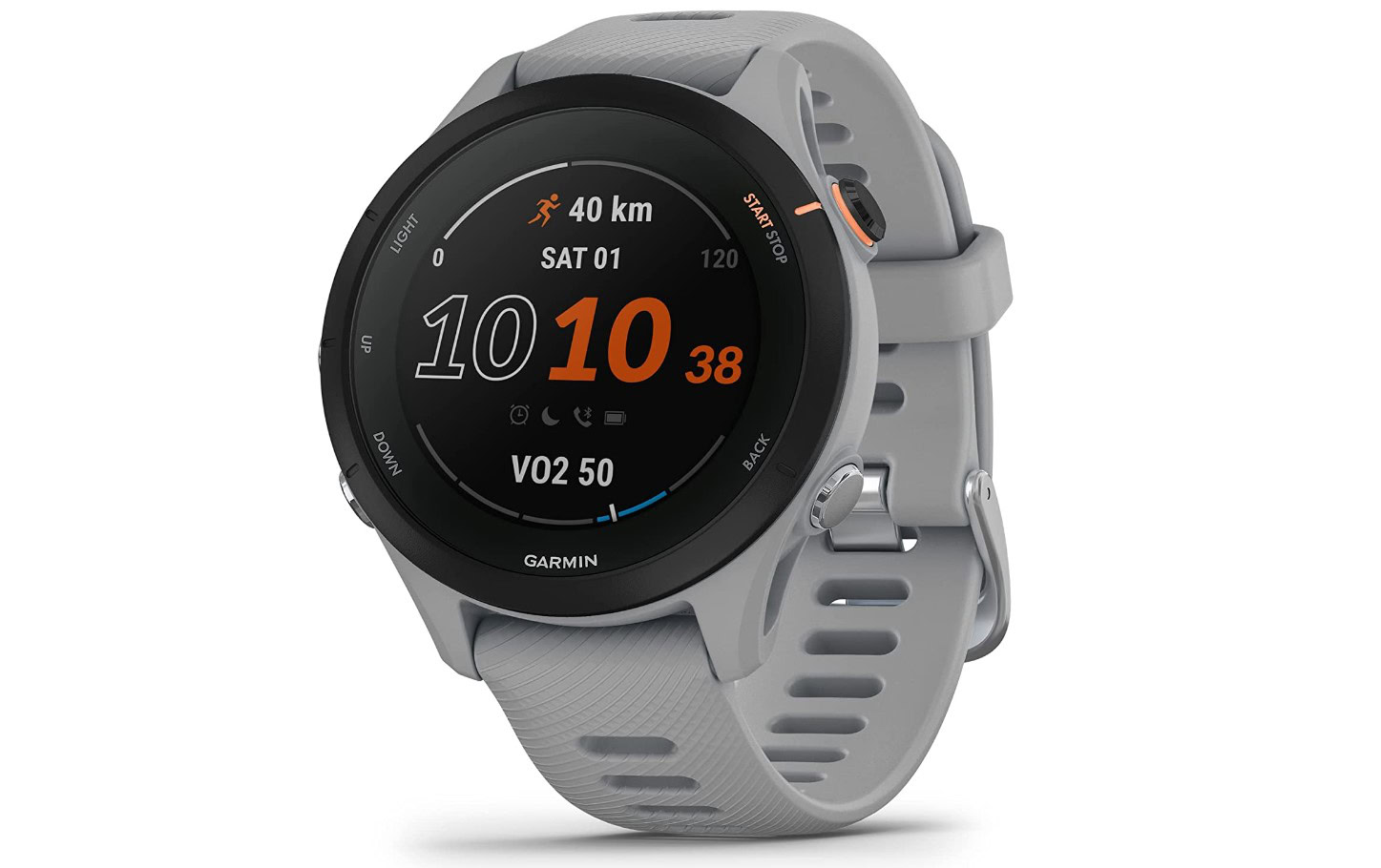
Garmin Forerunner 255
Garmin’s fan-favorite running watch is back with a few new wrinkles. The Forerunner 255 now supports NFC and Garmin Pay, along with a whole new set of sensors to spring it back onto the running watch podium.
Garmin Forerunner 255 top questions and answers
The Garmin Forerunner 255 is rated for 5ATM water resistance. That means you can submerge it in up to 50 meters of water without issue.
No, the Garmin Forerunner 255 does not have the ability to make calls. You can see notifications on the watch, but it does not have a microphone for calling.
Yes. The Garmin Forerunner 255 supports interchangeable quick-release bands. The 41mm version works with 18mm bands, while the 46mm version supports 22mm bands.
For all the latest Technology News Click Here
For the latest news and updates, follow us on Google News.
